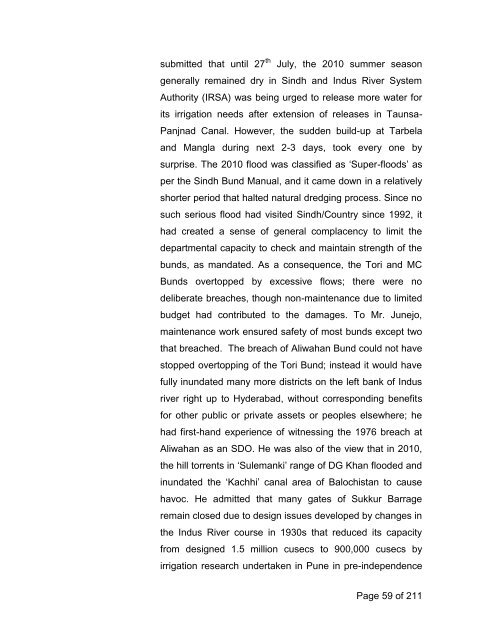Khawaja Zaheer Ahmed - PDMA
Khawaja Zaheer Ahmed - PDMA
Khawaja Zaheer Ahmed - PDMA
You also want an ePaper? Increase the reach of your titles
YUMPU automatically turns print PDFs into web optimized ePapers that Google loves.
submitted that until 27 th July, the 2010 summer season<br />
generally remained dry in Sindh and Indus River System<br />
Authority (IRSA) was being urged to release more water for<br />
its irrigation needs after extension of releases in Taunsa-<br />
Panjnad Canal. However, the sudden build-up at Tarbela<br />
and Mangla during next 2-3 days, took every one by<br />
surprise. The 2010 flood was classified as ‘Super-floods’ as<br />
per the Sindh Bund Manual, and it came down in a relatively<br />
shorter period that halted natural dredging process. Since no<br />
such serious flood had visited Sindh/Country since 1992, it<br />
had created a sense of general complacency to limit the<br />
departmental capacity to check and maintain strength of the<br />
bunds, as mandated. As a consequence, the Tori and MC<br />
Bunds overtopped by excessive flows; there were no<br />
deliberate breaches, though non-maintenance due to limited<br />
budget had contributed to the damages. To Mr. Junejo,<br />
maintenance work ensured safety of most bunds except two<br />
that breached. The breach of Aliwahan Bund could not have<br />
stopped overtopping of the Tori Bund; instead it would have<br />
fully inundated many more districts on the left bank of Indus<br />
river right up to Hyderabad, without corresponding benefits<br />
for other public or private assets or peoples elsewhere; he<br />
had first-hand experience of witnessing the 1976 breach at<br />
Aliwahan as an SDO. He was also of the view that in 2010,<br />
the hill torrents in ‘Sulemanki’ range of DG Khan flooded and<br />
inundated the ‘Kachhi’ canal area of Balochistan to cause<br />
havoc. He admitted that many gates of Sukkur Barrage<br />
remain closed due to design issues developed by changes in<br />
the Indus River course in 1930s that reduced its capacity<br />
from designed 1.5 million cusecs to 900,000 cusecs by<br />
irrigation research undertaken in Pune in pre-independence<br />
Page 59 of 211


